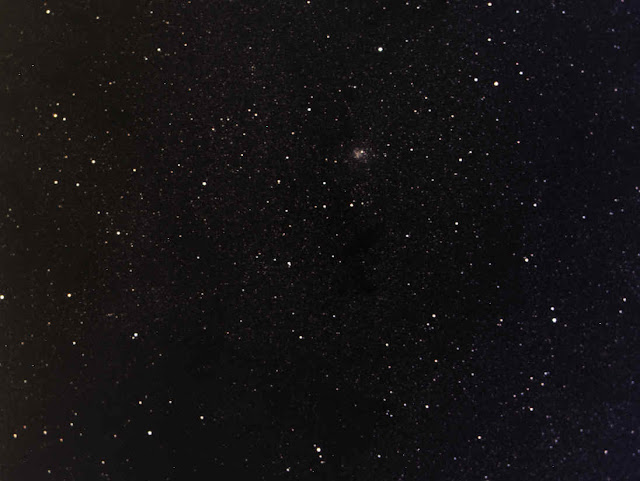It seems so long between imaging sessions at the scope that I forget how to image. Part of getting old, I guess. Plus, astronomical (or as I do it, astrocomical) imaging is a complex activity at the best of times. At any rate, I have imaged several objects since the last entry to the blog. And I can't say I'm impressed with the results, with one exception. That one will be obvious, I think. High clouds, high humidity, and light pollution all seem to conspire against astronomers trying to bring the beauty of the night sky to a computer near you. (Will it every change? Sigh.) Here is seen some of the latest trials and tribulations.

NGC 6401, the "fuzzy spot" to upper right of center.
Above is the globular cluster NGC6401. This is actually a color picture, it just doesn't seem so. If it shows up in the blog image, there is also a large “X” looking feature in about the center of the image. That is dust in front of the stars, blocking out the starlight. It's known as Barnard 82. The Barnard Catalog is a list of “dark nebulae” (basically areas of the sky where no light is coming through from the light source located behind it, whether that source is stars or a emission/reflection nebula) and was compiled and published in 1919 by Edward E. Barnard. A lot of the catalog can be found along the plane of the Milky Way, as in this case.
 |
| NGC 6823 et al. |
Above is and image of several things, one of which I haven't been able to identify yet. NGC6823 is the open cluster in the center of the picture. As far as I can tell, it's the brightest stars in the picture. I suspect several of the dimmer stars are included, but I have no idea which ones. NGC6820 is a small reflection nebula nearby. Reflection nebula are usually bluish in color. I can't say that I see anything like that in this image. The redish area is an emission nebula, which I think will be Sh 2-86. The “Sh” designation refers to an entry in the Sharpless catalog of emission nebula. The color image is composed of about 7 one minute exposures in each filter (LRGB), and I'm really not pleased with the result. However, the black and white image is the same image devoid of color. It would be (almost) the equivalent of 28 one minute exposures. I think it shows more detail. The take home message from this is that I suspect I will go back to this object and try to get more data by taking about 21 more images in each color and restacking them. Hopefully, this will make the color image at least as good as the b/w image. We'll see. If you look at the bottom edge, about ¼ the way towards the center you can see something that looks like a small comet. I haven't been able to identify this as yet. It could be part of the emission nebula that is “thicker” in that area, or it could be a comet or one of several other things. Currently, I'm betting on it being part of the nebula.
Finally, the above image is that of Caldwell 19. This one actually turned out pretty good, I thought. This one is also in the plane of the Milky Way, but much further North, closer to the star Deneb in The Swan.






